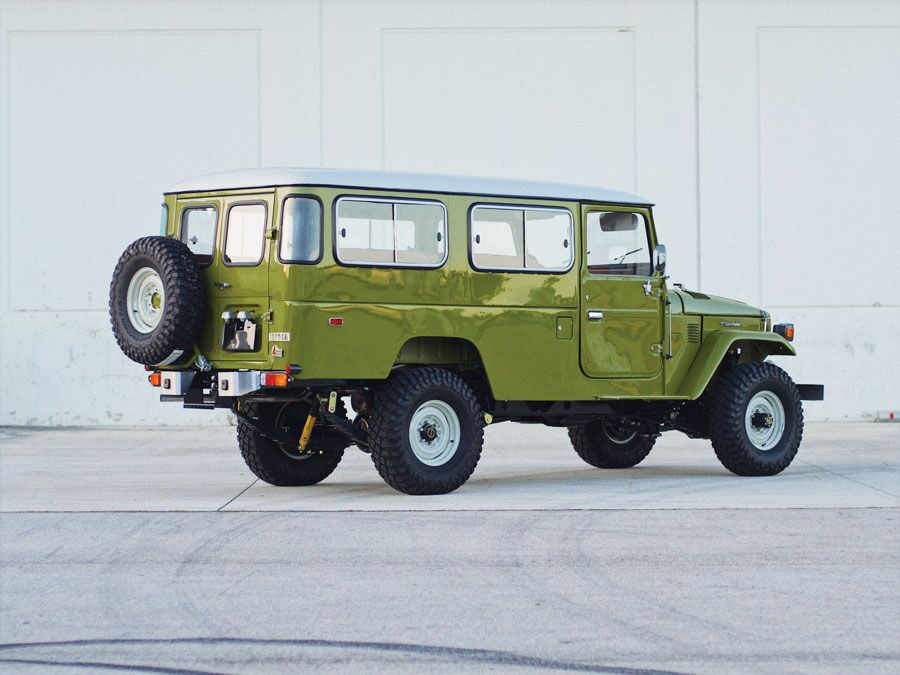SCM Analysis
Detailing
| Vehicle: | 1982 Toyota Land Cruiser FJ45 “Troopy” |
| Number Produced: | 462,000 (about 30,000 to the U.S.) |
| Original List Price: | $2,955 |
| SCM Valuation: | $50,600 (this car) |
| Chassis Number Location: | Stamped on the outer side of the right frame rail just behind the front bumper |
| Engine Number Location: | On the rear of block by the starter motor |
| Club Info: | Toyota Land Cruiser Association |
| Website: | http://tlca.org/ |
| Alternatives: | 1972 Toyota Land Cruiser FJ40, 1984 Toyota Land Cruiser FJ43, 1984 Toyota Land Cruiser FJ45 pickup |
| Investment Grade: | B |
This car, Lot 142, sold for $50,600, including buyer’s premium, at RM Sotheby’s Online Only Palm Beach, FL, auction on March 28, 2020.
Off-road trucks — new and classic — have never been more popular. Younger generations (X and Millennial) seem to be less interested in slinky sports coupes than they are in rough-and-tumble, ladder-frame 4×4 trucks and SUVs.
Over the past decade, I’ve watched the values of first-gen Broncos and early FJ40s climb out of the proverbial mud bog and soar into the stratosphere, reaching far beyond where any sane person might peg their value.
I mean, have you ever driven a 1968 Bronco? They were not well made, and they are not particularly fun to drive. They combine the agricultural-utility driving feel of a tractor with the build quality of a Ford Falcon — hardly confidence-inspiring.
Despite the questionable appeal of driving a half-century-old 4×4, there seemed virtually no market cap for 1960s and 1970s 4x4s. For years their prices tracked a steady line up and to the right.
Surprisingly, however, there has been a bit of a correction in the market in recent months. Since the novel coronavirus pandemic, prices of classic 4x4s have dipped.
I see this as especially odd for two reasons: First, the values of other collector vehicles don’t seem to have suffered quite as drastic a downturn during the pandemic. And secondly because — for the first time in my life — society seems to be in its most precarious place, teetering on the edge of collapse.
I don’t know about you, but if Western civilization were to crumble, I’d want a slightly softened military 4×4 in my fleet. You know, in case I needed to bug out into the wilderness for a while.
Maybe there aren’t as many folks who agree with me as I once thought. Or perhaps the recession has affected those attracted to vintage 4x4s more than others. I’m neither a sociologist nor an economist, so I won’t begin to pretend to know the answer to either of those theories.
What I do know, however, is that now is a great time to pick up a classic 4×4.
Reverse-engineering to excellence
For example, take the 1982 Toyota FJ45 Land Cruiser “Troopy” that sold at RM Sotheby’s Online Only auction on March 28, 2020, for $50,600. As a Toyota Land Cruiser enthusiast, I consider this truck incredibly well bought. But to explain why, we need to go back a bit to the origins of the truck itself.
The story of the Land Cruiser is a tale of classic post-World War II Japanese engineering: Take someone else’s idea, and then make it better. This is how the Toyota Land Cruiser was born, from a series of improvements on Western ideas.
The original Land Cruiser (a name “inspired” by the British-built Land Rover), the 20 Series, was a reverse-engineered U.S. military Jeep. How do we know this? The “J” in its codename stands for “Jeep.”
Although there were 40 Series Land Cruisers with different prefixes, the “F” in FJ45 referenced its engine: Toyota’s 3.9-liter inline 6-cylinder F engine, which was based on General Motors’ 235-cubic-inch I6 produced from 1937 to 1963. And, yes, you guessed it — the F was an improvement on the original GM design.
Our subject, the ’82 FJ45 Troopy, is fitted with the second generation of the venerable F engine, the 4.2-liter 2F, which premiered in 1975. The 2F churns out 135 horsepower and 210 foot-pounds of torque. This modicum of power was routed first to the rear wheels or to all four by engaging the 2-speed transfer case.
Zero to 60 mph for these trucks is measured in geologic time. However, climbing hills at highway speed is not what they’re built for. They were created to carry people and all their stuff over some of the toughest terrain in the world — at a snail’s pace.
With a simple steel body suspended with leaf springs over solid front and rear axles, the 40 Series cars were incredibly adept off-roaders — dead reliable ones at that.
Four doors or two doors
The longer-wheelbase FJ45s came in a couple variants: a 4-door wagon and a 2-door Troop Carrier (i.e. Troopy). Although the auction didn’t specify, we know this is a non-U.S.-market truck because Toyota replaced the FJ45 in the U.S. with the plusher FJ55 “Iron Pig” wagon in 1967.
No matter this truck’s provenance, it’s here in America now, and it’s received what appears to be an incredibly detailed frame-off restoration in January of this year. I doubt very much you could buy, import and restore this truck for $50,600.
To have bought one already done for that sum is astounding.
What’s more, the value of these trucks won’t stay down for long. The arc of the automotive industry is curving toward 4x4s. Jeep sells all the Wranglers it makes and recently added another variant to the model line: the Gladiator pickup. Ford is primed to reintroduce the Bronco, and GM is readying a Hummer revival — albeit a pure-electric pickup truck.
Right now, 4×4 prices might be down, but they won’t stay that way. I wouldn’t be surprised to see a Troopy like this fetch 30% more in a few years. ♦
